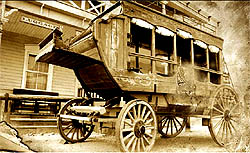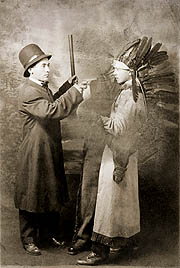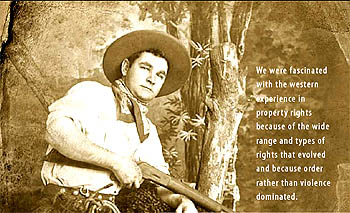More than thirty years ago, P. J. Hill and Terry Anderson published “An American Experiment in Anarcho-Capitalism: The Not So Wild, Wild West” in the Journal of Libertarian Studies. This was no typical western tale. Rather, this groundbreaking paper claimed that, the West, “although often dependent upon market peace-keeping agencies, was, for the most part, orderly.”
This article went on to discuss the evolution of property rights in the West through the formation of land claims clubs, cattlemens’ associations, rules governing claims in mining camps, and quasi-constitutions for wagon trains. The nineteenth century American West proved to be a useful testing ground for theories of spontaneous ordering through entrepreneurs who saw how property rights could be fashioned to minimize resource waste.
Hill and Anderson went a few steps further in The Not So Wild, Wild West: Property Rights on the Frontier (Stanford University Press, 2004), pointing out that the arrival of formal government changed the decision making in the West. Today, federal agencies such as the Forest Service and Bureau of Land Management control one-third of the nation’s land. On this land, use is allocated through political and bureaucratic processes, making it difficult to devolve decision making to the local level. But Hill explains, there are still lessons to be learned from the American Old West.
— Editor’s note
There is much evidence that well-defined and enforced property rights are necessary to direct human activity in useful ways. As young scholars, Terry Anderson and I were aware of this general thesis, but also thought evidence on where and how property rights evolve was thin. We were both raised in Montana; Terry the grandson of a miner and bootlegger and me the grandson of a rancher who started the P J Ranch. We discovered that our personal backgrounds and exposure to western history gave us a starting point for thinking about where rights come from. In 1979, we wrote:
Although the early West was not completely anarchistic, we believe that government as a legitimate agency of coercion was absent for a long enough period to provide insights into the operation and viability of property rights in the absence of a formal state. The nature of contracts for the provision of “public goods” and the evolution of western “laws” for the period from 1830 to 1900 will provide the data for this case study.
“How the West Was Won”
We were fascinated with the western experience in property rights because of the wide range and types of rights that evolved and because order rather than violence dominated. The basic idea was that bottom up, rather than top down, development of property rights, offered a useful tool for analyzing many resource issues. The American West provided an interesting place to develop the concept of institutional entrepreneurs. The lack of formal government structures meant that local people were able to devise rules that held individuals accountable for their actions. These rules, or property rights, also provided important feedback loops, which developed information and incentives for appropriate interaction.

In today’s world, however, it is difficult to replicate either the American West experience or Ostrom’s findings. Massive government ownership of forests and grazing land, large-scale government subsidies in water markets, and the view that all environmental problems are national issues that require centralized solutions stand in the way of effective institutional evolution.
Property rights are best formulated and modified by the people actually involved in using the resource, but most of the proposed solutions to environmental problems suffer from a central-planning mentality. President Nixon, for example, helped build an unprecedented bureaucratic morass: the National Environmental Policy Act, the Clean Air and Clean Water acts, and the Endangered Species Act. These policies have come with bloated bureaucracies spending billions of taxpayer dollars.
President Obama is now feeding the green goliath that Nixon helped create. Under his leadership, Congress has increased the Environmental Protection Agency’s budget to $10.5 billion in 2010 (a 35 percent increase) and passed the Omnibus Public Land Management Act, which includes 170 bills to federally shelter public lands and rivers at an estimated start-up cost of $6.4 billion.
This does not mean that there is no hope for effective solutions to resource issues, however. The world is full of institutional entrepreneurs. When given the freedom to develop innovative contracts that alter the sticks in the property rights bundle, such entrepreneurs can be found in many places— including Indian reservations.
“Little Big Man”
As Terry and I explain in The Not So Wild, Wild West (2004), “There is no better place to begin examining why the American West was not so wild than with the ‘red man’s law.’” Despite a lack of formalized governing structures, pre-Colombian Indians understood the tragedy of the commons well and created rules and order to protect their resources. Today, entrepreneurial tribes such at the Salish and Kootenai of the Flathead Indian Reservation in Montana are proving that, like their ancestors, they too are very capable of managing their resources.
There is no better place to begin examining why the American West was not so wild than with the ‘red man’s law.’
In 1995, the forestry department of the Confederated Salish and Kootenai Tribes compacted with the federal government under Public Law 93-638. This move allowed the tribes to break free from the chains of the Bureau of Indian Affairs and gave them full rein over their forestry decisions.
The result of this arrangement has been positive for both the tribes’ economic health and for the ecological health of the reservation. In a PERC Policy Series, “Two Forests under the Big Sky,” Alison Berry (2009) compared the Flathead Reservation with the neighboring Lolo National Forest and discovered that on both the cost and output sides of the equation, the tribes do a better job than the federal government.

Despite these similarities, however, there is a big difference in the dollar return and unit output between the reservation and federal forest timber programs. According to Berry, the Lolo harvested 57 percent more timber between 1998 and 2005 than the Flathead, yet it generated much lower returns. In this period the tribes’ gross revenue from timber exceeded $16 million, while the Lolo’s gross revenue was $2.5 million. In other words, the tribal forest averaged $2.04 in annual revenues for every dollar spent, whereas the Lolo averaged $1.11.
The Tribes of the Flathead rely on timber revenues to support tribal operations and have a direct interest in the continuing vitality of their natural resources. As Jim Durglo, tribal forest manager said, “Our forest is a vital part of everyday tribal life. Timber production, non-timber forest products, and grazing provide jobs and income for tribal members and enhance the economic life of surrounding communities.”
There are numerous other examples of bottomup institutional entrepreneurship at work. Ranchers are reclaiming trout streams on their land, brokers are discovering how to market water rights to encourage exchanges between farmers and anglers who want instream water for amenity purposes, and those who value wildlife are compensating ranchers for livestock loss due to predators. In each case, getting government to reduce its heavy hand of control is important for these innovative solutions to occur.





